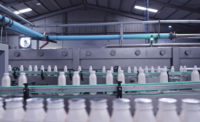Maximizing product protection, freshness, convenience and shelf appeal govern packaging decisions about dairy foods. These goals are driving interest in aseptic filling, in-mold labeling, single-serving sizes and functional features.
Sustainability hasn’t been forgotten, either. Suppliers continue to lightweight structures and replace nonrenewable materials with renewable ones. The dairy industry also is addressing concerns about food waste.
Trends in long shelf life dairy foods
“Aseptic products extend shelf life, usually at least twice as long as conventionally packaged products,” said James Hurley, the CEO of TRU Aseptics, a Wisconsin-based contract manufacturer of shelf-stable, preservative-free and minimally processed high- and low-acid ingredients.
The benefits of aseptic packaging go beyond shelf life. They provide supply chain efficiencies, cut costs and reduce carbon footprint by eliminating the need for a refrigerated distribution infrastructure.
“It’s a safer product to ship and store,” Hurley said.
The longer and non-refrigerated shelf life of products makes it possible for dairy processors to expand distribution.
“In the export business, packaging that helps to protect the product and offers logistical benefits plays an important role,” said Claudia Goertz, laminates product manager for SIG Combibloc, Switzerland. “Aseptic carton packs provide the best possible protection and ensure a long shelf life,” she explained.
Such cartons also rank as an environmentally friendly packaging option, an important benefit for manufacturers, retailers and consumers, she noted.
Hurley said another issue favoring aseptics is an edict from consumer packaged goods companies requiring the phase-out of ingredients in frozen concentrate form after 2020.
With so many potential benefits, “the dairy industry is now witnessing a paradigm shift toward aseptic processing and packaging,” said Ismail Sutaria, packaging consultant at Transparency Market Research, Albany, N.Y.
So it’s not surprising that TRU Aseptics anticipates double-digit growth through 2020 in the low-acid aseptic market. When production starts around Sept. 1 this year, the company’s highly automated plant will produce bulk formats ranging from 2-liter bag-in-boxes to 330-gallon totes. Equipment there includes an Alpha Laval HS/LA high-speed, low-acid filler and a StarAsept filler from Liqui-Box.
On the material side, combibloc RS (Robust Structure) laminate upgrades the polymer used for the inner layers of the cartons filled on SIG Combibloc filling machines while lightweighting the overall structure. The lighter weight reduces the carbon footprint of each package up to 6%. There is also said to be a reduction in downtime and waste due to significantly wider tolerances for bottom and top sealing.
Shelf impact from shrink sleeves, IML
In-mold labeling and full-body shrink sleeve labels help dairy foods and beverages stand out in retailers’ refrigerated cases. One “game changing” breakthrough development is the thermoformed in-mold-labeled container (TIML), said Sutaria of Transparency Market Research. Chicago-based Coveris teamed up with the Finnish dairy processor Valio to form TIML containers.
“This packaging format provides 360-degree illustrations that cover the container wall to the sealing rim,” Sutaria said.
Benefits include a 20% decrease in weight, use of lightweight multilayer sheets with a gas-injected middle layer and optional filler material. The containers also can offer enhanced oxygen and 100% ultraviolet light barriers, which extend shelf life and protect the organoleptic properties of high-fat products.
South Africa’s Dairymaid and its suppliers won 2017 Worldstar and 2016 Afristar awards for in-mold labeling innovation on packages of Country Fresh ice cream. The in-mold label covers the entire lid on 1.5- and 1.8-liter tubs. The eye-catching seamless design excels in user-friendliness with its “open here” flag in the corner. The package stacks securely and efficiently, which means stability during transport, not to mention the benefit to retailers who can stock up to 25% more product. Advanced injection molding technology cuts packaging weight 10% and reduces its carbon footprint.
The tubs were produced in conjunction with Constantia Verstraete IML of Belgium and Dairypack Tubs, a division of Polyoak Packaging of South Africa.
Flexible FFS cheese pouches
Aesthetic appeal and convenience are responsible for an uptick in interest in premade pouches for specialty cheese packaging.
“You can’t beat the polished look of a premade bag. Their convenience aspects make them even more appealing,” said Rick Leonhard, president of Viking Masek, a supplier of fill-seal and form-fill-seal equipment based in Oostburg, Wis. “Premade pouches do cost more per package, but we are seeing that artisanal cheese producers and packagers are willing to pay a premium for a premium look. Consumers see premade bags as value-added as well.”
Products that reduce meal prep time for busy home cooks continue to proliferate. Examples are shredded cheese in reclosable standup pouches or ready-to-serve cheese trays. Demand for single-serving packs also is growing and “compelling packaging manufacturers to offer smaller packaging formats for dairy products,” said Sutaria of Transparency Market Research.
Leonhard also has observed the rising demand for single-serving formats and notes flexible packaging is particularly popular.
“Products like sour cream and yogurt that have for many years been packaged in rigid plastic containers are now being packaged in flexible pouches,” he said. “Some of these packages are preformed stand-up pouches, and others are single-serve stick packs. Manufacturers have been discovering that offering the same product in a flexible packaging format does not cannibalize their core product line. In fact, it increases their customer base by appealing to a different demographic.”
Packaging for convenience
For liquid dairy products consumed on-the-go, Texas-based Tetra Pak introduced two smaller portion packages, the Tetra Prisma Aseptic 200 (milliliters) and 250 (milliliters) Edge with DreamCap 26.
Then there are packages with built-in utensils. A leading ice cream maker in the Balkans is Ledo, based in Zagreb, Croatia. It packages a dairy-based dessert known as “kremsnita” in a spoon-equipped 210-milliliter pot from RPC Superfos of Denmark.
Evidently, the pot is popular with consumers, who promote it on social media. Ledo Product Manager Lovro Vučković said “we have found many pictures and positive comments about our dessert, and our customers love the spoon, too.”
Some new products go beyond traditional convenience features. For example, Vermont Creamery, Websterville, Vt., chose a small ceramic crock for its non-GMO-certified St. Albans aged cheese. The crock not only protects the cheese in distribution, but also serves as its baking vessel.
“When popped into the oven, you can create a silky, molten fondue for two,” said the creamery’s Director of Marketing FM Muñoz. “The marriage of functionality and design adds value for the consumer and makes for a unique product experience,” he said.
Sometimes, packaging can create a new product segment. Look at the coffee creams category where DanoneWave packages its International Delight One Touch Latte in a steel aerosol can with a specialized actuator. The aerosol froths the coffee cream, enabling preparation of lattes. Printed 360-degree graphics differentiate the vanilla, mocha and caramel flavors.
Addressing sustainability, food waste
As consumers become increasingly focused on issues of sustainability and environmental stewardship, opportunities arise for new or improved packaging formats and materials. One “green” introduction is Sentinel renewable ice cream board from Evergreen Packaging, Memphis, Tenn. It features an extrusion coating of sugarcane-based polyethylene from Braskem, based in São Paulo, Brazil. Burd & Fletcher, a carton maker in Independence, Mo., is using the material.
“We believe that the introduction of our Envy ice cream container will not only assist with the growing sustainability movement in the frozen dairy market, but also contribute to solidifying consumers’ brand loyalty by providing more eco-friendly options,” said John Nycklemoe, Burd & Fletcher’s chief sales officer.
To ensure optimum disposal at the end of the product life cycle, How2Recycle labels are slowly penetrating the category. For example, Target Corp., Minneapolis, has added the information to a convenience pack of 12 individually wrapped bars of its Market Pantry brand Cheddar cheese. The back panel of the outer pouch presents recycling information for the multilayer bag as well as the multilayer wrap.
Efforts to combat food waste are gaining momentum. The International Dairy Foods Association supports food industry efforts to streamline and standardize the wording of “best by” and “use by” date labels on packages. IDFA is working with the National Consumers League to expand its consumer education program to reduce food waste. Other actions are focused on resolving conflicting state laws that could prevent dairy processors from adopting standardized date labels.
Smarter future
Increasing consumption of dairy foods and beverages is transforming the dairy industry. Packaging consultant Sutaria said “rising per capita consumption is expected to create colossal demand for dairy product packaging.”
With shelf life of perishable products remaining a top-of-mind concern, he predicted the next innovations will center on “smart” packaging that monitors product freshness.
Use the bottle cap to promote milk’s protein content
Understanding MAP
“How modified atmosphere packaging extends the shelf life of food products” is a white paper from Witt. http://tinyurl.com/kbplva9







